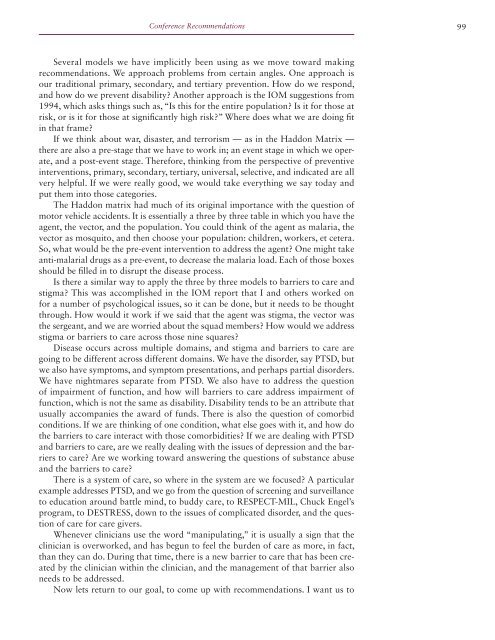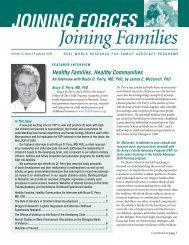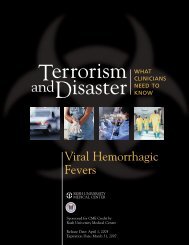stigma and barriers to care - Uniformed Services University of the ...
stigma and barriers to care - Uniformed Services University of the ...
stigma and barriers to care - Uniformed Services University of the ...
Create successful ePaper yourself
Turn your PDF publications into a flip-book with our unique Google optimized e-Paper software.
Conference Recommendations 99<br />
Several models we have implicitly been using as we move <strong>to</strong>ward making<br />
recommendations. We approach problems from certain angles. One approach is<br />
our traditional primary, secondary, <strong>and</strong> tertiary prevention. How do we respond,<br />
<strong>and</strong> how do we prevent disability Ano<strong>the</strong>r approach is <strong>the</strong> IOM suggestions from<br />
1994, which asks things such as, “Is this for <strong>the</strong> entire population Is it for those at<br />
risk, or is it for those at significantly high risk” Where does what we are doing fit<br />
in that frame<br />
If we think about war, disaster, <strong>and</strong> terrorism — as in <strong>the</strong> Haddon Matrix —<br />
<strong>the</strong>re are also a pre-stage that we have <strong>to</strong> work in; an event stage in which we operate,<br />
<strong>and</strong> a post-event stage. Therefore, thinking from <strong>the</strong> perspective <strong>of</strong> preventive<br />
interventions, primary, secondary, tertiary, universal, selective, <strong>and</strong> indicated are all<br />
very helpful. If we were really good, we would take everything we say <strong>to</strong>day <strong>and</strong><br />
put <strong>the</strong>m in<strong>to</strong> those categories.<br />
The Haddon matrix had much <strong>of</strong> its original importance with <strong>the</strong> question <strong>of</strong><br />
mo<strong>to</strong>r vehicle accidents. It is essentially a three by three table in which you have <strong>the</strong><br />
agent, <strong>the</strong> vec<strong>to</strong>r, <strong>and</strong> <strong>the</strong> population. You could think <strong>of</strong> <strong>the</strong> agent as malaria, <strong>the</strong><br />
vec<strong>to</strong>r as mosqui<strong>to</strong>, <strong>and</strong> <strong>the</strong>n choose your population: children, workers, et cetera.<br />
So, what would be <strong>the</strong> pre-event intervention <strong>to</strong> address <strong>the</strong> agent One might take<br />
anti-malarial drugs as a pre-event, <strong>to</strong> decrease <strong>the</strong> malaria load. Each <strong>of</strong> those boxes<br />
should be filled in <strong>to</strong> disrupt <strong>the</strong> disease process.<br />
Is <strong>the</strong>re a similar way <strong>to</strong> apply <strong>the</strong> three by three models <strong>to</strong> <strong>barriers</strong> <strong>to</strong> <strong>care</strong> <strong>and</strong><br />
<strong>stigma</strong> This was accomplished in <strong>the</strong> IOM report that I <strong>and</strong> o<strong>the</strong>rs worked on<br />
for a number <strong>of</strong> psychological issues, so it can be done, but it needs <strong>to</strong> be thought<br />
through. How would it work if we said that <strong>the</strong> agent was <strong>stigma</strong>, <strong>the</strong> vec<strong>to</strong>r was<br />
<strong>the</strong> sergeant, <strong>and</strong> we are worried about <strong>the</strong> squad members How would we address<br />
<strong>stigma</strong> or <strong>barriers</strong> <strong>to</strong> <strong>care</strong> across those nine squares<br />
Disease occurs across multiple domains, <strong>and</strong> <strong>stigma</strong> <strong>and</strong> <strong>barriers</strong> <strong>to</strong> <strong>care</strong> are<br />
going <strong>to</strong> be different across different domains. We have <strong>the</strong> disorder, say PTSD, but<br />
we also have symp<strong>to</strong>ms, <strong>and</strong> symp<strong>to</strong>m presentations, <strong>and</strong> perhaps partial disorders.<br />
We have nightmares separate from PTSD. We also have <strong>to</strong> address <strong>the</strong> question<br />
<strong>of</strong> impairment <strong>of</strong> function, <strong>and</strong> how will <strong>barriers</strong> <strong>to</strong> <strong>care</strong> address impairment <strong>of</strong><br />
function, which is not <strong>the</strong> same as disability. Disability tends <strong>to</strong> be an attribute that<br />
usually accompanies <strong>the</strong> award <strong>of</strong> funds. There is also <strong>the</strong> question <strong>of</strong> comorbid<br />
conditions. If we are thinking <strong>of</strong> one condition, what else goes with it, <strong>and</strong> how do<br />
<strong>the</strong> <strong>barriers</strong> <strong>to</strong> <strong>care</strong> interact with those comorbidities If we are dealing with PTSD<br />
<strong>and</strong> <strong>barriers</strong> <strong>to</strong> <strong>care</strong>, are we really dealing with <strong>the</strong> issues <strong>of</strong> depression <strong>and</strong> <strong>the</strong> <strong>barriers</strong><br />
<strong>to</strong> <strong>care</strong> Are we working <strong>to</strong>ward answering <strong>the</strong> questions <strong>of</strong> substance abuse<br />
<strong>and</strong> <strong>the</strong> <strong>barriers</strong> <strong>to</strong> <strong>care</strong><br />
There is a system <strong>of</strong> <strong>care</strong>, so where in <strong>the</strong> system are we focused A particular<br />
example addresses PTSD, <strong>and</strong> we go from <strong>the</strong> question <strong>of</strong> screening <strong>and</strong> surveillance<br />
<strong>to</strong> education around battle mind, <strong>to</strong> buddy <strong>care</strong>, <strong>to</strong> RESPECT-MIL, Chuck Engel’s<br />
program, <strong>to</strong> DESTRESS, down <strong>to</strong> <strong>the</strong> issues <strong>of</strong> complicated disorder, <strong>and</strong> <strong>the</strong> question<br />
<strong>of</strong> <strong>care</strong> for <strong>care</strong> givers.<br />
Whenever clinicians use <strong>the</strong> word “manipulating,” it is usually a sign that <strong>the</strong><br />
clinician is overworked, <strong>and</strong> has begun <strong>to</strong> feel <strong>the</strong> burden <strong>of</strong> <strong>care</strong> as more, in fact,<br />
than <strong>the</strong>y can do. During that time, <strong>the</strong>re is a new barrier <strong>to</strong> <strong>care</strong> that has been created<br />
by <strong>the</strong> clinician within <strong>the</strong> clinician, <strong>and</strong> <strong>the</strong> management <strong>of</strong> that barrier also<br />
needs <strong>to</strong> be addressed.<br />
Now lets return <strong>to</strong> our goal, <strong>to</strong> come up with recommendations. I want us <strong>to</strong>




